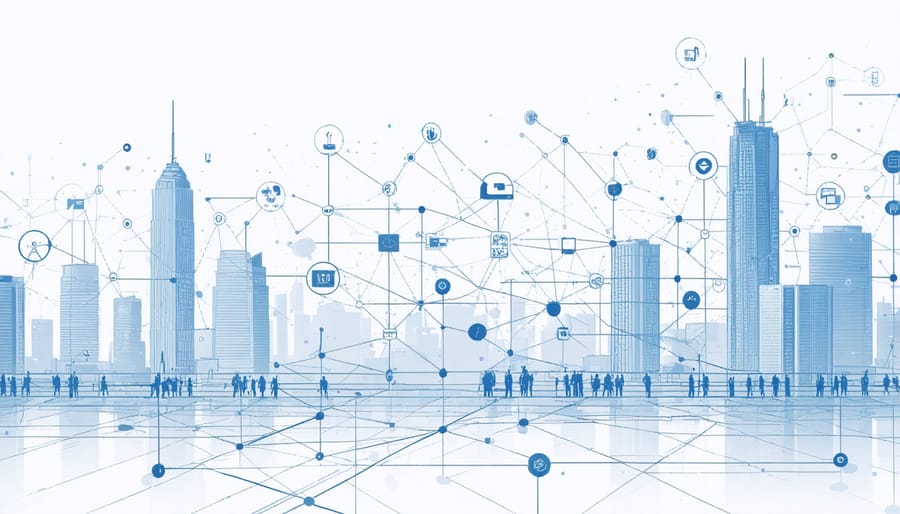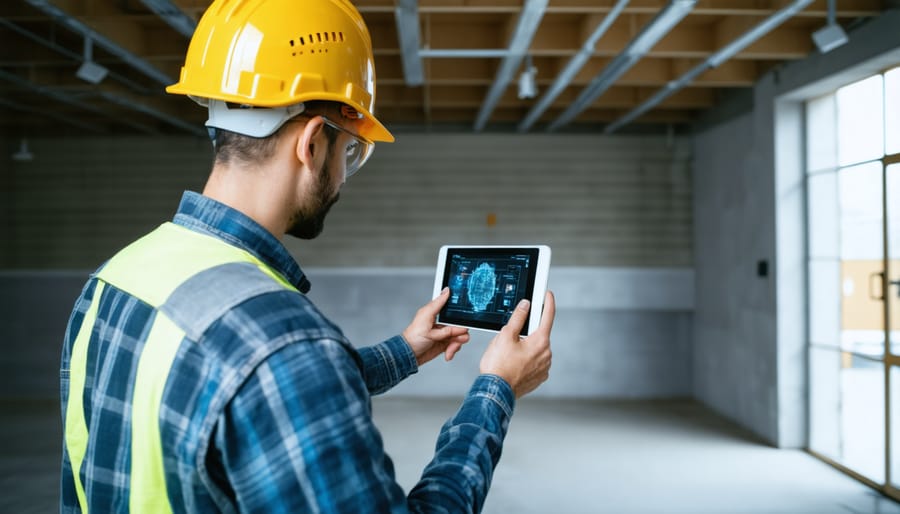Revolutionary smart city initiatives across the United States are fundamentally transforming urban development, with over $41 billion invested in digital infrastructure projects since 2020. As smart city infrastructure foundations evolve from concept to reality, construction industry leaders are witnessing unprecedented integration of IoT sensors, AI-driven systems, and advanced data analytics into traditional urban frameworks.
Major metropolitan areas like New York, Chicago, and San Francisco are spearheading large-scale digital transformation projects that combine robust physical infrastructure with sophisticated technological capabilities. These initiatives encompass everything from intelligent traffic management systems and smart energy grids to automated waste collection and real-time environmental monitoring networks.
For construction professionals and urban planners, this technological revolution demands a fundamental shift in project planning and execution methodologies. The convergence of construction expertise with digital innovation is creating new opportunities for infrastructure development while establishing higher standards for urban sustainability and operational efficiency. Understanding these emerging smart city frameworks is no longer optional—it’s imperative for staying competitive in today’s rapidly evolving construction landscape.
Leading Smart City Initiatives Transforming American Infrastructure
Columbus Smart City Challenge Success Story
Columbus, Ohio’s Smart City Challenge victory in 2016, securing a $40 million federal grant, catalyzed a transformative urban development initiative that has become a blueprint for smart city implementation across the United States. The project, which ultimately leveraged over $500 million in public and private investments, focused on key infrastructure improvements and technological integration.
The city’s comprehensive approach addressed critical urban challenges through multiple interconnected initiatives. A standout achievement was the deployment of connected vehicle technology across 113 intersections and 1,100 vehicles, reducing traffic congestion by 18% and emergency response times by 25%. The installation of smart streetlights equipped with environmental sensors has generated annual energy savings of $1.2 million while providing valuable data for urban planning.
Columbus’s success particularly shines in its electric vehicle adoption strategy, increasing EV ownership by 500% since project inception. The city implemented 914 charging stations and developed a sophisticated mobility platform integrating various transportation modes, improving accessibility for underserved communities.
The project’s data-driven approach has yielded measurable results in urban efficiency. The Smart Columbus Operating System processes over 2,000 data sets daily, enabling real-time decision-making for infrastructure management. This systematic integration of technology with traditional infrastructure has demonstrated how smart city initiatives can deliver tangible benefits while maintaining cost-effectiveness, serving as a model for future urban development projects nationwide.

San Francisco’s Connected Corridor Project
San Francisco’s Connected Corridor Project represents a pioneering approach to intelligent transportation infrastructure, integrating advanced technologies along key arterial routes throughout the Bay Area. The project, launched in 2021, encompasses a 12-mile stretch of primary corridors, featuring an interconnected network of smart traffic signals, environmental sensors, and real-time data analytics systems.
At the heart of the initiative are adaptive traffic management solutions that utilize artificial intelligence to optimize signal timing based on current traffic patterns. Over 150 intersections have been equipped with advanced detection systems and IoT sensors, enabling real-time monitoring of vehicle flow, pedestrian movement, and public transit operations.
The project’s infrastructure backbone includes fiber-optic communication networks supporting high-speed data transmission between traffic control centers and field devices. Connected vehicle technology (CV2X) has been implemented at key intersections, allowing direct communication between infrastructure and equipped vehicles to enhance safety and reduce congestion.
Environmental considerations are integrated through smart streetlighting systems that adjust illumination based on ambient conditions and movement detection. The corridor also features electric vehicle charging infrastructure and dedicated lanes for autonomous vehicles, preparing for future transportation needs.
Initial data shows a 23% reduction in travel times during peak hours and a 15% decrease in emissions within the corridor. The project serves as a model for other metropolitan areas, demonstrating how integrated smart infrastructure can enhance urban mobility while promoting sustainability and safety.
Technical Infrastructure Components

IoT Integration in Urban Infrastructure
Modern smart city initiatives across the United States are increasingly leveraging IoT integration in urban infrastructure to create interconnected systems that enhance operational efficiency and public services. These sophisticated sensor networks form the backbone of data-driven urban management, incorporating thousands of interconnected devices that monitor everything from traffic patterns to air quality.
Cities like Chicago have deployed over 500 nodes across their urban landscape, creating a network of environmental sensors that collect real-time data on temperature, humidity, air quality, and vibration levels. This comprehensive monitoring system enables predictive maintenance of infrastructure assets and immediate response to environmental concerns.
In San Diego, smart streetlights equipped with advanced sensors not only optimize energy consumption but also gather valuable data on pedestrian movement patterns and parking availability. The city’s sensor network has resulted in a 25% reduction in energy costs while providing crucial insights for urban planning decisions.
Boston’s Smart Streets initiative demonstrates the practical application of IoT sensors in traffic management. The system utilizes connected devices to adjust traffic signal timing based on real-time conditions, reducing congestion by up to 15% during peak hours. Additionally, embedded road sensors monitor surface conditions, automatically alerting maintenance crews to potential issues before they become critical problems.
These sensor networks are increasingly being integrated with cloud-based platforms that enable real-time data analysis and visualization. This integration allows city managers to make informed decisions about resource allocation, infrastructure maintenance, and emergency response, while providing valuable data for future urban development planning.
5G Network Implementation
The implementation of 5G networks in smart cities represents a critical infrastructure component that enables seamless integration of various urban technologies. Major metropolitan areas like New York, Chicago, and Los Angeles are investing heavily in 5G infrastructure, with telecommunications providers deploying thousands of small cell nodes throughout urban corridors.
These advanced networks provide the essential backbone for IoT devices, autonomous vehicles, and smart utility systems, delivering ultra-low latency and high-bandwidth connectivity. Current implementations typically involve strategic placement of 5G equipment on existing urban infrastructure, including light poles, buildings, and traffic signals, reducing deployment costs while maximizing coverage.
According to recent industry data, smart city projects utilizing 5G technology have demonstrated significant improvements in data transmission speeds, with latency reduced to less than 1 millisecond and bandwidth capabilities reaching up to 20 Gbps. This enhanced connectivity supports real-time monitoring of critical infrastructure, enabling predictive maintenance and rapid response to urban challenges.
Cities like San Francisco and Atlanta have pioneered innovative approaches to 5G implementation, incorporating network equipment into street furniture and developing underground fiber networks to support wireless connectivity. These initiatives have established dedicated channels for emergency services, traffic management systems, and public safety applications.
The deployment strategy typically follows a phased approach, prioritizing high-density areas and critical infrastructure corridors. Municipal governments are increasingly partnering with private sector entities through public-private partnerships (P3s) to accelerate network deployment while sharing costs and risks associated with infrastructure development.
Construction Industry Impact and Opportunities
New Construction Standards and Requirements
Modern smart city initiatives have fundamentally transformed traditional building codes and infrastructure specifications across the United States. The International Code Council (ICC) has introduced smart-ready requirements that mandate the integration of IoT sensors, digital connectivity infrastructure, and automated building management systems in new construction projects exceeding 50,000 square feet.
Key requirements now include the installation of smart meter systems for real-time utility monitoring, building automation systems (BAS) with open-protocol architecture, and infrastructure to support 5G connectivity. New buildings must incorporate dedicated spaces for edge computing facilities and meet minimum standards for network redundancy to ensure reliable smart system operations.
Structural specifications have evolved to accommodate sensor networks, with requirements for integrated conduit systems and access points at regular intervals. Energy efficiency standards now mandate smart lighting systems with occupancy detection and automated HVAC controls that can integrate with citywide management platforms.
Data security has become a crucial component, with requirements for separate networks for building operations and public access. Construction plans must include cybersecurity measures and demonstrate compliance with NIST guidelines for smart infrastructure protection.
These standards are being adopted progressively, with major metropolitan areas like New York, Chicago, and San Francisco leading implementation. Projects must demonstrate compliance during both the design phase and through post-construction verification, ensuring long-term smart city integration capabilities.
Future-Proofing Construction Projects
In today’s rapidly evolving urban landscape, future-proofing smart construction has become a critical consideration for project success. Leading developers are implementing strategic approaches to ensure new buildings and infrastructure can readily adapt to emerging technologies.
Key strategies include installing robust IT infrastructure with excess capacity for future expansion, implementing modular systems that allow for easy upgrades, and incorporating flexible building management systems. Construction professionals are now designing dedicated spaces for IoT sensors, creating specialized conduits for fiber optic cables, and planning for increased power requirements of smart systems.
Successful implementations require careful consideration of scalability during the initial design phase. This includes oversizing electrical systems, incorporating redundant network pathways, and designing mechanical rooms with space for future smart equipment. Progressive builders are also installing empty conduits and junction boxes throughout structures to accommodate future technological additions without major renovations.
Additionally, developers are adopting open-architecture platforms that can integrate with various smart city systems. This approach ensures buildings can connect seamlessly with municipal infrastructure while maintaining the flexibility to upgrade as new technologies emerge. Documentation of all smart provisions, including as-built drawings and specifications for future reference, has become standard practice in forward-thinking construction projects.

Future Development Roadmap
The next five years are poised to bring transformative developments in U.S. smart city initiatives, with several major metropolitan areas unveiling ambitious infrastructure modernization plans. Industry experts project investments exceeding $100 billion in smart infrastructure projects through 2028, focusing primarily on data-driven transportation systems, sustainable energy solutions, and advanced connectivity networks.
Key emerging trends include the integration of 5G-enabled sensors throughout urban environments, with cities like Boston and Seattle leading the implementation of comprehensive IoT networks for real-time infrastructure monitoring. These systems will enable predictive maintenance capabilities and optimize resource allocation across municipal services.
Autonomous vehicle infrastructure is gaining significant traction, with Pittsburgh and Austin developing dedicated smart corridors equipped with advanced traffic management systems and vehicle-to-infrastructure communication capabilities. These projects are expected to serve as blueprints for nationwide implementation of connected transportation networks.
Energy infrastructure modernization remains a priority, with Miami and Houston investing in climate-resilient power grids incorporating renewable energy sources and intelligent distribution systems. These projects emphasize the integration of microgrids and advanced energy storage solutions to enhance grid reliability during extreme weather events.
Smart water management systems are becoming increasingly crucial, with drought-prone regions like California’s Bay Area implementing AI-driven leak detection and usage optimization technologies. These initiatives are expected to reduce water waste by up to 30% while improving distribution efficiency.
Looking ahead, industry leaders anticipate increased focus on cybersecurity infrastructure, with cities implementing blockchain-based systems for secure data management and critical infrastructure protection. Additionally, public-private partnerships are expected to play a larger role in project funding and implementation, with several major tech companies announcing smart city collaboration initiatives.
The construction industry can expect growing demand for professionals skilled in digital infrastructure integration and sustainable building practices. As these projects advance, emphasis will be placed on modular construction techniques and prefabricated components designed specifically for smart city applications.
As the United States continues to embrace smart city initiatives, the construction industry stands at the forefront of this technological revolution. The successful implementation of smart city projects across major metropolitan areas demonstrates the growing maturity of these solutions and their potential to transform urban infrastructure. Key success factors have emerged from pioneering projects, including robust public-private partnerships, standardized data protocols, and scalable infrastructure designs.
Looking ahead, the smart city landscape in the USA is poised for significant growth, with experts projecting investments to exceed $41 billion by 2025. The focus is shifting toward integrated solutions that combine multiple smart technologies, from intelligent transportation systems to energy-efficient buildings and advanced waste management solutions. Construction professionals must prepare for this evolution by developing expertise in IoT implementation, data analytics, and sustainable building practices.
The lessons learned from current projects underscore the importance of flexible infrastructure design that can accommodate future technological advances. Success will depend on the industry’s ability to adopt standardized protocols, ensure cybersecurity measures, and create interoperable systems that can evolve with changing urban needs.
For construction industry stakeholders, the opportunity lies in positioning themselves as key enablers of smart city transformation. This requires staying current with emerging technologies, developing specialized expertise, and fostering collaborative relationships with technology providers and municipal authorities. The future of smart cities in the USA will be shaped by those who can effectively bridge the gap between traditional construction practices and innovative digital solutions.

